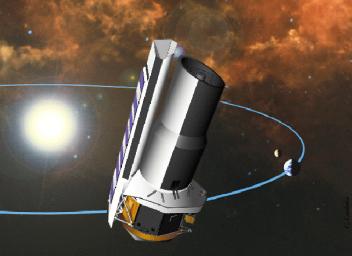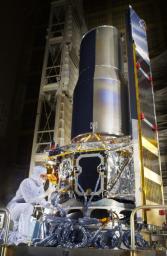
Posted on 12/19/2003 11:10:18 PM PST by concentric circles
A new window to the universe has opened with today's release of the first dazzling images from NASA's newly named Spitzer Space Telescope, formerly known as the Space Infrared Telescope Facility.
The first observations, of a glowing stellar nursery; a swirling, dusty galaxy; a disc of planet-forming debris; and organic material in the distant universe, demonstrate the power of the telescope's infrared detectors to capture cosmic features never before seen.
The Spitzer Space Telescope was also officially named today after the late Dr. Lyman Spitzer, Jr. He was one of the 20th century's most influential scientists, and in the mid-1940s, he first proposed placing telescopes in space.
"NASA's newest Great Observatory is open for business, and it is beginning to take its place at the forefront of science," said NASA's Associate Administrator for Space Science, Dr. Ed Weiler. "Like Hubble, Compton and Chandra, the new Spitzer Space Telescope will soon be making major discoveries, and, as these first images show, should excite the public with views of the cosmos like we've never had before."
"The Spitzer Space Telescope is working extremely well. The scientists who are starting to use it deeply appreciate the ingenuity and dedication of the thousands of people devoted to development and operations of the mission," said Dr. Michael Werner, project scientist for the Spitzer Space Telescope at NASA's Jet Propulsion Laboratory, Pasadena, Calif.
Launched Aug. 25 from Cape Canaveral, Fla., the Spitzer Space Telescope is the fourth of NASA's Great Observatories, a program designed to paint a more comprehensive picture of the cosmos using different wavelengths of light.
While the other Great Observatories have probed the universe with visible light (Hubble Space Telescope), gamma rays (Compton Gamma Ray Observatory) and X-rays (Chandra X-ray Observatory), the Spitzer Space Telescope observes the cosmos in the infrared. Spitzer's unprecedented sensitivity allows it to sense infrared radiation, or heat, from the most distant, cold and dust-obscured celestial objects. Today's initial images revealed the versatility of the telescope and its three science instruments. The images:

-- Resembling a creature on the run with flames streaming behind it, the Spitzer image of a dark globule in the emission nebula IC 1396 is in spectacular contrast to the view seen in visible light. Spitzer's infrared detectors unveiled the brilliant hidden interior of this opaque cloud of gas and dust for the first time, exposing never-before-seen young stars.

-- The dusty, star-studded arms of a nearby spiral galaxy, Messier 81, are illuminated in a Spitzer image. Red regions in the spiral arms represent infrared emissions from dustier parts of the galaxy where new stars are forming. The image shows the power of Spitzer to explore regions invisible in optical light, and to study star formation on a galactic scale.

-- Spitzer revealed, in its entirety, a massive disc of dusty debris encircling the nearby star Fomalhaut. Such debris discs are the leftover material from the building of a planetary system. While other telescopes have imaged the outer Fomalhaut disc, none was able to provide a full picture of the inner region. Spitzer's ability to detect dust at various temperatures allows it to fill in this missing gap, providing astronomers with insight into the evolution of planetary systems.

-- Data from Spitzer of the young star HH 46-IR, and from a distant galaxy 3.25 billion light-years away, show the presence of water and small organic molecules not only in the here and now, but, for the first time, far back in time when life on Earth first emerged.
JPL manages the Spitzer Space Telescope mission for NASA's Office of Space Science, Washington. Science operations are conducted at the Spitzer Science Center at the California Institute of Technology in Pasadena. Major partners are Lockheed Martin Corporation, Sunnyvale, Calif.; Ball Aerospace & Technologies Corporation, Boulder, Colo.; NASA's Goddard Space Flight Center, Greenbelt, Md.; Boeing North America (now DRS Technologies, Inc.) Anaheim, Calif.; the University of Arizona, Tucson; and Raytheon Vision Systems, Goleta, Calif. The instrument principal investigators are Dr. Giovanni Fazio, Harvard-Smithsonian Center for Astrophysics, Cambridge, Mass.; Dr. James Houck, Cornell University, Ithaca, N.Y.; and Dr. George Rieke, University of Arizona, Tucson.


You can JUUUUUUST make out this:

Astronomy Picture Of the Day. (Will open in a new window.)
The above is a link to a NASA site that has good astronomy pictures. However, today's picture is of the Helios vehicle.
If you were looking at photos taken with the exact same telescope, but instead it was based "out there" somewhere and peering in on Earth's little corner of the cosmos (the Milky Way galaxy), you'd see something similar (and probably get the same feeling of lonliness). The (spiral) galaxy to which we belong looks nearly identical to the one in the second pic from the top in this article, with Earth being located in one of the outer spiral arms. With around 100 million stars - suns - in each galaxy, it's difficult to say just how lonely it is out there.

The magnificent spiral arms of the nearby galaxy Messier 81 are highlighted in this image from NASA's Spitzer Space Telescope. Located in the northern constellation of Ursa Major (which also includes the Big Dipper), this galaxy is easily visible through binoculars or a small telescope. M81 is located at a distance of 12 million light-years.
The main image is a composite mosaic obtained with the multiband imaging photometer and the infrared array camera. Thermal infrared emission at 24 microns detected by the photometer (red, bottom left inset) is combined with camera data at 8.0 microns (green, bottom center inset) and 3.6 microns (blue, bottom right inset).
A visible-light image of Messier 81, obtained with a ground-based telescope at Kitt Peak National Observatory, is shown in the upper right inset. Both the visible-light picture and the 3.6-micron near-infrared image trace the distribution of stars, although the Spitzer image is virtually unaffected by obscuring dust. Both images reveal a very smooth stellar mass distribution, with the spiral arms relatively subdued.
As one moves to longer wavelengths, the spiral arms become the dominant feature of the galaxy. The 8-micron emission is dominated by infrared light radiated by hot dust that has been heated by nearby luminous stars. Dust in the galaxy is bathed by ultraviolet and visible light from nearby stars. Upon absorbing an ultraviolet or visible-light photon, a dust grain is heated and re-emits the energy at longer infrared wavelengths. The dust particles are composed of silicates (chemically similar to beach sand), carbonaceous grains and polycyclic aromatic hydrocarbons and trace the gas distribution in the galaxy. The well-mixed gas (which is best detected at radio wavelengths) and dust provide a reservoir of raw materials for future star formation.
The 24-micron multiband imaging photometer image shows emission from warm dust heated by the most luminous young stars. The infrared-bright clumpy knots within the spiral arms show where massive stars are being born in giant H II (ionized hydrogen) regions. Studying the locations of these star forming regions with respect to the overall mass distribution and other constituents of the galaxy (e.g., gas) will help identify the conditions and processes needed for star formation.






Technicians put final touches on NASA's Space Infrared Telescope Facility at Lockheed Martin Aeronautics in Sunnyvale, Calif. It will soon be shipped to Cape Canaveral, Florida, where it is scheduled to launch on April 15. The mission will observe the coldest, oldest and most dust-obscured objects in the universe.
 |
Just keep your terran hands off my Eludium Q-32 Space Modulator, hoomin! |

While it'd be possible to hard code the mapping of IR spectra to visible colors, I have heard that sometimes the final product is "tuned" to make the clearest picture. I think that is what the original poster was referring to.
What they do (and I am no expert)is have the tops of those telescopes (the round part) be able to rotate at the same speed as the earth turns.
When the sun goes down they focus on one small speck in the sky and turn that big baby on and leave it all night.
What it does is collect light. Its like a timed exposure sort of because the light is SO faint.
They have massive mirrors inside that are specially crafted that reflect the light.
I think they turn those signals that are captured actually into numbers. If you saw the raw data it looks like a print out of just long pages of numbers about 30 feet long. Those images are actually recorded numerically (I think).
Then they take that data and put it into a computer than can read it and turn it into images.
BTW they put those scopes in Hawaii on top of mountains because of several reasons 1) Dust. the ocean traps much of the dust. 2)the height makes a difference. 3) the station on the globe.
From what I understand even the earths own atmosphere distorts the light...so sometimes the pics are a no go...
I have to find the literature they gave me when I was there in order to confirm all of this :o)
Thats why they are moving into putting telescopes in space...
But hey, I don't know anything about astronomy.
Disclaimer: Opinions posted on Free Republic are those of the individual posters and do not necessarily represent the opinion of Free Republic or its management. All materials posted herein are protected by copyright law and the exemption for fair use of copyrighted works.